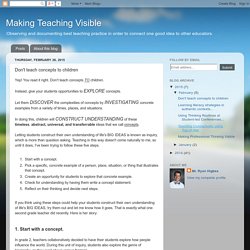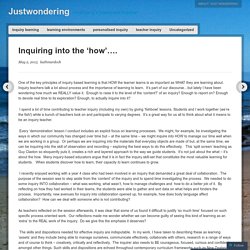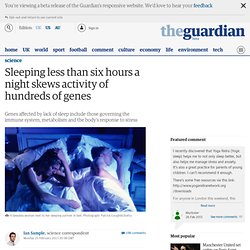

Making Teaching Visible: Don't teach concepts to children. Yep!

You read it right. Don't teach concepts TO children. Instead, give your students opportunities to EXPLORE concepts.Let them DISCOVER the complexities of concepts by INVESTIGATING concrete examples from a variety of times, places, and situations.In doing this, children will CONSTRUCT UNDERSTANDING of these timeless, abstract, universal, and transferrable ideas that we call concepts. Letting students construct their own understanding of life's BIG IDEAS is known as inquiry, which is more than question asking.
Teaching in this way doesn't come naturally to me, so until it does, I've been trying to follow these five steps.Start with a concept.Pick a specific, concrete example of a person, place, situation, or thing that illustrates that concept.Create an opportunity for students to explore that concrete example. The next day, the teacher simply gave students a blank piece of paper and prompted them to write all they understood about heroes. First, the students started with ... 5. Inquiring into the ‘how’…. One of the key principles of inquiry based learning is that HOW the learner learns is as important as WHAT they are learning about.

Inquiry teachers talk a lot about process and the importance of learning to learn. It’s part of our discourse…but lately I have been wondering how much we REALLY value it. Enough to raise it to the level of the ‘content?’ Of an inquiry? Enough to report on? I spend a lot of time contributing to teacher inquiry (including my own) by giving ‘fishbowl’ lessons. Every ‘demonstration’ lesson I conduct includes an explicit focus on learning processes.
I recently enjoyed working with a year 4 class who had been involved in an inquiry that demanded a great deal of collaboration. As teachers reflected on the session afterwards, it was clear that some of us found it difficult to justify ‘so much time’ focused on such specific process oriented work. Visual Literacy, Big Data and Infographics. Created by Nicki Hambleton, UWCSEA, @itsallaboutart The mash-up of visual literacy and Big Data empowers and prepares students and schools for a future in which they have the skills to mine, scrape, collect, store and analyze structured and unstructured data.

We need to ask ourselves three questions: What questions are we asking of this data? How are we using data in our schools to support curriculum and pedagogy? How do we strengthen learner's visual literacy skills to thrive in a media saturated world? This site is about giving learning communities the skills to do the following: Learn how infographics can disseminate information Explore, evaluate and critique readily available infographicsUse images, text and media to tell a story using an infographic platform You've come to the right place....
Infographics and data visualizations are utilized to support digital, informational and media literacy in the digital age. ProDivas! - Welcome to ProDivas! (1) Edmodo. Coolcatteacher.sharedby. Creative Commons. Watch. Sleeping less than six hours a night skews activity of hundreds of genes. Getting too little sleep for several nights in a row disrupts hundreds of genes that are essential for good health, including those linked to stress and fighting disease.

Tests on people who slept less than six hours a night for a week revealed substantial changes in the activity of genes that govern the immune system, metabolism, sleep and wake cycles, and the body's response to stress, suggesting that poor sleep could have a broad impact on long-term wellbeing. The changes, which affected more than 700 genes, may shed light on the biological mechanisms that raise the risk of a host of ailments, including heart disease, diabetes, obesity, stress and depression, in people who get too little sleep. "The surprise for us was that a relatively modest difference in sleep duration leads to these kinds of changes," said Professor Derk-Jan Dijk, director of the Surrey Sleep Research Centre at Surrey University, who led the study.
Find free images online! Images are an important part of the creative side of any educators’s work.

We need to make use of quality image sources that are good, free, and easy to search through. The trick is to know what sources to recommend to students. It’s not just about copyright – its about being practical, and showing students the wonderful world of possibilities beyond Google images or taking anything they find that is not actually in the public domain – a vital point as more students and teachers move into online environments of blogs, wikis and more. Including images with postings enriches the experience for the reader and can also help to illustrate or support the writer’s viewpoint. Flickr is my top favourite which also has an advanced search option. Flickr Creative Commons compiles images that Flickr users who chosen to offer their work under a Creative Commons license, and you can browse or search through content under each type of license.
FlickrCC Attribution Helper – outstanding! By Beverly & Pack. Are you painting your own masterpiece? - Launchyourgenius. Get Launch Your Genius in your e-mail INBOX!

Are You Launching Your Genius Today? I BELIEVE that deep within every single one of us lies the potential of a GENIUS! Bringing the best of Creativity, Personal Development and Behavioral Psychology! Move towards launching your own creative genius TODAY! Download your free picture e-books: GENERATE NEW IDEAS (12.5 MB) AND MASTERY (10.7 MB)! Your name and email address will never EVER be distributed or sold. I Can Has Cheezburger? - Lolcats n Funny Pictures - funny pictures - Cheezburger.